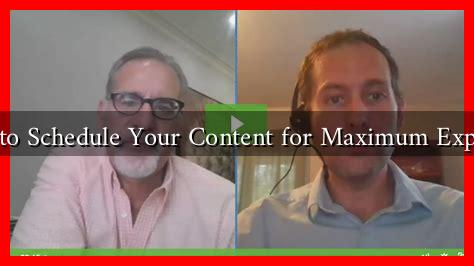-
Table of Contents
How to Schedule Your Content for Maximum Exposure
In the digital age, content is king, but timing is everything. Scheduling your content effectively can significantly enhance its visibility and engagement. This article will explore strategies for scheduling your content to maximize exposure, backed by research, statistics, and real-world examples.
Understanding Your Audience
Before you can effectively schedule your content, you need to understand your audience. Knowing when your target demographic is most active online is crucial for maximizing exposure. Here are some steps to help you gather this information:
- Analyze Audience Insights: Use tools like Google Analytics and social media insights to determine when your audience is most active.
- Conduct Surveys: Ask your audience directly about their preferred times for consuming content.
- Monitor Competitors: Observe when your competitors post and how their audience engages with that content.
For instance, a study by Sprout Social found that the best times to post on social media vary by platform. For example, the optimal time to post on Facebook is Wednesday at 11 a.m., while Instagram sees the most engagement on Fridays between 10 a.m. and 11 a.m.
Choosing the Right Platforms
Not all content performs equally across different platforms. Understanding where your audience spends their time can help you tailor your scheduling strategy. Here are some popular platforms and their characteristics:
- Facebook: Best for longer-form content and community engagement.
- Instagram: Ideal for visual content and stories; engagement peaks during lunch hours and evenings.
- Twitter: Great for real-time updates and news; posts should be scheduled during peak hours for maximum visibility.
- LinkedIn: Best for B2B content; weekdays during business hours are optimal.
By tailoring your content to the right platform, you can enhance its reach and engagement. For example, a B2B company might find that posting case studies on LinkedIn during the workweek yields better results than posting the same content on Instagram.
Utilizing Scheduling Tools
To streamline your content scheduling process, consider using scheduling tools. These tools can help you automate posting, analyze performance, and optimize your strategy. Some popular options include:
- Hootsuite: Allows you to schedule posts across multiple platforms and provides analytics.
- Buffer: Offers a simple interface for scheduling and analyzing social media posts.
- CoSchedule: Integrates with your blog and social media, allowing for a comprehensive content calendar.
Using these tools can save you time and ensure that your content is posted at the optimal times for maximum exposure.
Creating a Content Calendar
A content calendar is an essential tool for organizing your content strategy. It helps you plan ahead, ensuring that you have a consistent flow of content. Here’s how to create an effective content calendar:
- Define Your Goals: What do you want to achieve with your content? Increased traffic, engagement, or conversions?
- Plan Your Content Types: Mix different types of content, such as blog posts, videos, infographics, and social media updates.
- Schedule Regular Reviews: Regularly assess your content’s performance and adjust your strategy as needed.
For example, a lifestyle brand might schedule blog posts on Mondays, Instagram stories on Wednesdays, and Facebook live sessions on Fridays to maintain a diverse content strategy throughout the week.
Measuring Success and Adjusting Your Strategy
Finally, measuring the success of your content scheduling is crucial. Use analytics tools to track engagement, reach, and conversions. Key performance indicators (KPIs) to consider include:
- Engagement rates (likes, shares, comments)
- Website traffic from social media
- Conversion rates from specific campaigns
By analyzing this data, you can identify what works and what doesn’t, allowing you to adjust your scheduling strategy accordingly. For instance, if you notice that posts scheduled on Thursdays receive more engagement than those on Mondays, consider shifting your focus.
Conclusion
Scheduling your content for maximum exposure requires a strategic approach that considers your audience, platform characteristics, and the use of scheduling tools. By understanding when your audience is most active, choosing the right platforms, utilizing scheduling tools, creating a content calendar, and measuring success, you can significantly enhance your content’s visibility and engagement. Remember, the key to effective content scheduling is flexibility; be prepared to adjust your strategy based on performance data and audience feedback.
For more insights on content marketing strategies, check out HubSpot’s Marketing Statistics.

